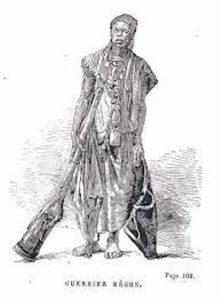
John Cabess (likeness)
*The birth of John Cabess is affirmed on this date in c. 1640. He was an African slave trader and merchant.
John Cabess (also known as John Kabes or John Cabes) was the son of John Cabessa, a prominent African official working for the British at Fort Amsterdam in the 1660s. His father was most noted in British reports for committing suicide rather than becoming a captive while the Dutch were attacking Fort Amsterdam. The city of Komenda, part of the Kingdom of Eguafo, had become a major trade port in the later parts of the 17th century.
The British and French wanted to get a foothold in the port to break the Dutch monopoly over trade in the Gold Coast. The Dutch, in contrast, saw it as a secondary port to support its other operations in the area. In this situation, Cabess moved to Komenda in the 1670s to work with the British attempts to establish trade relationships in the port. At this point, he provided shells, food, and labor for fort and factory construction by the Royal African Company in Komenda and elsewhere along the coast.
Eventually, Cabess became a major slave trader out of the port of Komenda, supplying thousands of slaves continually. His refusal to trade with the Dutch significantly slowed their ability to build facilities. When the French took an interest in developing a factory at Komenda, they offered Cabess a significant amount of gold to help them in the project (a deal that was never finalized). Cabess had significant negotiating leverage in his relationship with the British, sometimes resulting from intense relations. In 1687, tensions between Cabess and the Royal African Company representative in the fort, William Cross, resulted in Cross being forcibly removed from the post. Similar situations occurred in 1698 and 1714, both times with the British representative being replaced at the request of Cabess.
In 1688, Cabess was panyarred by the Dutch, a practice common in the area where other merchant forces would capture merchants and traders, and their goods would be taken. The British merchants secured Cabess' release, and according to some accounts, this precipitated his attack on Dutch miners in 1694, which started the Komenda Wars. In 1690, during a war between the Dutch and French trading companies, the British factory was burnt down, and they left the area. Cabess, therefore, began supplying goods and manpower to the Dutch. With the end of the wars after 1700 and the rise of the Ashanti Empire in trade along the coast, Cabess became a crucial middleman in the port city.
British traders complained that Cabess would prevent traders from directly entering Komenda and instead intercept them outside of the city trading for their goods and then charging a higher rate to the British while keeping some of the best goods for themselves. Cabess then became able to manage contacts with multiple sellers and multiple buyers but kept them from directly contacting each other, thus centralizing buying and selling within his control.
The economic position of Cabess created conflict with the British, who became quite hostile to one another by 1705. However, although he traded with the Dutch, he remained a significant British ally for the rest of his life, and the tension quickly decreased. This economic position also introduced rivalries with other African powers: a series of hostile activities between Twifo and Cabess in 1714 required the adjudication of Ashanti diplomats.
Economic importance translated into increasing political importance, and Cabess became the virtual leader of Komenda, who became less subordinate to the city of Eguafo and gradually became equal. In addition, Cabess began owning land around Komenda that he directly controlled. At his death, he essentially held sovereign power along the coast. John Cabess died in June 1722 in Komenda. The British and Dutch feared a large succession struggle among his many heirs. The RAC administrators dispatched an officer to provide gifts to those members most likely to take the place of Cabess. After a public viewing of his body, he was buried at the British fort in Komenda. His son Ahenaqua took over much of the trade and political power of Cabess without a recorded succession struggle. Until the chiefs at Cape Coast became predominant over Komenda in the mid-1700s, the main office at Komenda, the Caboceer, governed on what was known as "the stool of the late John Cabess."
Become a Purchasing Manager or Buyer
To become a Financial Management Analyst